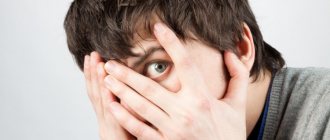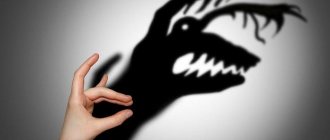Psychosis is a complex mental disorder that can have a hidden course. That is why it is almost impossible to determine the development of pathology in the early stages. Some symptoms characteristic of the disease have certain similarities with hereditary diseases and various syndromes. There is a certain pattern of development of the pathology in question, thanks to which an accurate diagnosis can be made.
At the initial stages of the development of psychosis, the patient experiences changes in behavior patterns that manifest themselves in the form of atypical reactions. At the next stage, the perception of the surrounding world is disrupted, which provokes changes in consciousness. Next, the balance of the emotional background is disturbed, which is expressed in the form of a discrepancy between the feelings experienced and the situation. There are also more pronounced symptoms of the disease, which we will discuss below.
Psychosis symptoms
A person suffering from mental disorders experiences a number of changes in behavior, emotions, and thinking. The basis of this metamorphosis is the loss of adequate perception of the real world. It becomes impossible for a person to realize what is happening, as well as to assess the severity of mental changes. The patient experiences a depressed state, he is haunted by hallucinations and delusional statements.
Hallucinations include talking to oneself, laughing for no reason, listening and falling silent, looking preoccupied. The feeling that a relative of the patient hears something he is unable to perceive.
Delusions are understood as changed behavior, the appearance of secrecy and hostility, direct statements of a dubious nature (persecution, one’s own greatness or irredeemable guilt).
General information
Psychosis (in English - psychosis) is a condition characterized by a pronounced disturbance of mental activity.
The patient’s mental reactions come into significant conflict with the real situation. The patient’s perception of the real world is disrupted, his behavior becomes disorganized, and syndromes and symptoms unusual for a normal state appear. When talking about what psychosis is, sometimes this concept is equated to the disease schizophrenia . However, the detailed approach is fundamentally flawed, since psychotic disorders are diagnosed in various mental illnesses, not just schizophrenia. In addition, people experience psychosis as a result of taking drugs, treatment with certain medications, the development of certain somatic diseases, etc. Due to the influence of very strong psychological trauma, a mentally healthy person can experience so-called reactive psychosis, which is a short-term condition.
During a psychotic disorder, a person may experience hallucinations , most often auditory, as well as delusions. Typically, symptoms occur periodically. Today, psychotic disorders are a fairly common form of pathology.
The features of the manifestation of psychosis, its varieties and treatment options will be discussed in this article.
Psychosis: phases of disorder
As a rule, psychoses have a periodic course with sudden or naturally occurring attacks. However, psychotic pathologies can also become chronic, acquiring a continuous course with constant demonstration of symptoms.
The phases of any type of psychosis include:
- prodromal stage – the period from the manifestation of one-time symptoms to their subsequent constant demonstration;
- stage of untreated psychosis – the interval from the onset of constant demonstration of symptoms of psychosis until the start of treatment for the disease;
- acute phase – the stage characterized by the peak of the disease and the maximum intensity of the symptoms of the disorder;
- residual phase - a stage of decreasing intensity of symptoms of psychosis, lasting several years.
Signs of psychosis
- Hallucinations : auditory, olfactory, visual, tactile and gustatory. The most common characteristic is the appearance of auditory hallucinations, perceived by patients as a voice inside the head or from outside.
- Crazy ideas . They include judgments and conclusions that are not true. The patient is completely captivated by these ideas, and it is impossible to prove or convince him. The most common delusions of persecution (surveillance), negative influence (aliens, KGB), delusions of causing damage (theft, poison in food, survival from home). Sometimes delusions of grandeur, illness, jealousy and others may occur.
- Movement disorders . It may manifest itself as stupor, in which the patient remains in one position for a long time, and inactivity. He does not try to answer questions, his gaze is fixed on one point. Or the person is in an excited state: he moves and speaks without stopping, makes a grimace, tries to imitate people and be aggressive and do strange things.
- Mood disorders: being in a depressive or manic state.
Types of psychoses
Classification of psychoses based on etiology and pathogenetic mechanisms:
- endogenous - such psychoses include schizophrenia, psychotic disorders, schizoaffective disorder and psychotic forms of affective disorders;
- organic – develop with various head injuries and other brain lesions;
- somatogenic – develop against the background of diseases of internal organs;
- psychogenic - such psychoses can be reactive or situational;
- intoxication – develop as a result of drug use;
- withdrawal symptoms;
- alcoholic;
- post-withdrawal.
According to another classification, psychoses are:
- Endogenous - develops in the presence of internal or neuroendocrine disorders. The presence of organic brain damage is not typical.
- Exogenous - develop as a result of the influence of external factors.
- Organic – develop as a result of traumatic brain injury, neuroinfections, various brain tumors, atherosclerosis. Mental disorders develop as a result of somatic diseases.
Intoxication psychosis - causes, symptoms, treatment, diagnosis
Intoxication psychosis is the general name for a group of diseases that are characterized by various mental disorders due to the ingestion of poisons into the body.
Mental disorders can manifest themselves as a result of a single exposure to toxic substances, or they can become the body’s reaction to long-term intoxication - over several months or even years.
Most severe acute poisonings result in the death of the patient; in other cases, with timely treatment, the person can fully or partially recover.
- All information on the site is for informational purposes only and is NOT a guide to action!
- can give you an ACCURATE DIAGNOSIS !
- We kindly ask you NOT to self-medicate, but to make an appointment with a specialist !
- Health to you and your loved ones!
Causes
The main cause of intoxication psychoses is an exogenous factor, namely the ingestion of toxic substances into the body.
The degree of poisoning and severity of consequences depend on the following circumstances:
- amount of toxins;
- duration of exposure to toxic substances on humans;
- the rate at which toxins enter the body;
- metabolic features of a particular person.
The rapid intake of large doses of poison into the body has a toxic effect on any healthy person. Drug addicts and substance abusers develop addiction, so their central nervous system reacts to toxic substances in a nonspecific way: the person loses hearing or falls into a coma.
When exposed to smaller amounts of poison, the body's reaction depends on the age and gender of the person, the characteristics of his constitution, diet and concomitant somatic diseases.
Depending on these factors, toxic effects may be directed at certain body systems, or may not occur at all. Often intoxication psychosis becomes a manifestation of allergies.
There are 6 groups of substances that provoke the development of the disease:
- pesticides for industry and agriculture - lead, pesticides and insecticides;
- household toxins - lighting gas;
- toxic substances in food – ergot;
- psychomimetics;
- medications;
- substances that cause drug addiction and substance abuse.
This division of toxins into groups is not entirely correct. For example, insecticides are sometimes used in everyday life, and long-term use of drugs such as sleeping pills and central nervous system stimulants can lead to substance abuse. However, a more precise classification of substances that cause intoxication psychoses has not been developed. There were no statistics on the incidence of the disease.
Symptoms
Since there are a lot of toxic substances, and the degree of their impact on the body of each person depends on many factors, the symptoms of intoxication psychoses are also diverse.
When intoxicated as a result of using tricyclic antidepressants, the following symptoms are observed:
- comatose states;
- epileptiform seizures;
- manic disorders;
- delirium;
- twilight states.
Teturam poisoning is determined by the following characteristics:
- asthenic syndrome;
- delirious and delirious-oneiric states;
- twilight states;
- depression;
- manic disorders;
- catatonic syndrome;
- paranoia;
- hallucinations;
- pseudoparalysis;
- convulsions.
Poisoning with completely different substances often leads to similar mental disorders. Thus, delirium is observed after intoxication as a result of the use of both tricyclic antidepressants and teturam. The same symptom is present in poisoning with carbon monoxide, barbiturate, lead, and ether.
Forms
It has been scientifically proven that intoxication with previously unknown substances does not provoke the appearance of new symptoms. For this reason, all attempts by scientists to identify specific signs characterizing poisoning with a specific poison have not been successful.
However, the clinical forms of intoxication psychoses during intoxication with different poisons still differ.
| Acute |
|
| Chronic | With long-term intoxication of the body with moderate doses of poison, psychosis can take a chronic form, in which a variety of psychopathological symptoms are observed:
All signs of the chronic form of psychosis do not decrease, but, on the contrary, increase: from mild mental disorders to severe ones - up to loss of consciousness and comatose states. In case of quinacrine poisoning, the clinical picture of the disease resembles manic-depressive psychosis. Symptoms of intoxication with hashish, mercury vapor or phenamine are similar to those of schizophrenia. In this case, in addition to hallucinations and delusions, disorders of thinking and the emotional-volitional sphere, which are considered characteristic of schizophrenia, may be observed. Sometimes there is a rapid change of symptoms and their polymorphism. Thus, with intoxication psychosis, a syndrome of organic brain damage can develop. It can be pseudoparalytic in case of barbiturate poisoning, Korsakovsky - in case of intoxication with alcohol and carbon monoxide, parkinsonian - in case of poisoning with neuroleptics and manganese. Some of these symptoms often go away on their own - for example, Korsakoff's syndrome due to carbon monoxide poisoning, neuroleptic parkinsonism and pseudoparalysis due to the use of barbiturates. However, sometimes the exact opposite is true. Thus, antipsychotic drugs cause certain motor disorders. At first, these signs can be mistaken for psychogenic, since they appear in a state of excitement, anxiety, under the influence of suggestion, and disappear when the person calms down. However, after some time, when the patient takes medications, these symptoms become permanent and sometimes irreversible. Symptoms are relieved after exposure to toxic substances is eliminated, and sometimes completely eliminated. The speed of recovery of the body depends on the type of poison that has entered it: when intoxicated by lead and mercury vapors, the signs of the disease persist for a long time, phenamine psychoses pass faster. Long-term exposure to small portions of poison provokes the development of borderline mental disorders, which are relatively mild. At the same time, the very definition of “small portions” is relative, since if a substance causes intoxication, its permissible dose has already been greatly exceeded. Asthenic syndrome is constantly present, often provoking the appearance of neurotic and psychopathic changes in a person’s reaction to the disease. |
Diagnostics
Intoxication psychoses are diagnosed by two highly specialized doctors: a narcologist and a psychiatrist. First of all, the patient will be asked to take a drug test, since there may be a possibility that intoxication with this particular substance caused psychosis.
If no drugs were found in the patient’s blood, the narcologist questions the patient about the effects of any poisons on him.
After this, laboratory tests are carried out, the results of which should show the presence of toxins or their metabolites in biological fluids in the patient’s body. If the detected substances cause characteristic symptoms, it will be easier to make a diagnosis.
The following signs are characteristic:
| Delirium | When exposed to anticholinergic drugs. |
| Hallucinations and paranoia | When taking central nervous system stimulants. |
| Depression | When using antipsychotics. |
| Manic syndrome | When taking antidepressants and quinine. |
| Amnestic syndrome | In case of carbon monoxide intoxication. |
Also in the diagnostic process, it is important to pay attention to the nature of somatic disorders. Thus, skin rashes are characteristic of bromism, brown pigmentation is characteristic of fluoride intoxication. Changes in internal organs occur during alcohol poisoning, nervous system disorders occur during intoxication, and damage to the basal ganglia characterizes poisoning with manganese and carbon monoxide.
Another important step in the diagnosis is to distinguish intoxication psychosis from other forms of the disease. Due to the similarity in symptoms and nature of the course of the disease, it can be very difficult to distinguish, for example, drug-induced psychosis from infectious psychosis.
The doctor will have to establish a relationship between the effect of the toxic substance and the appearance or reduction of psychosis itself. To do this, an anamnesis of the disease is taken and it is analyzed whether the dynamics of mental disorders are associated with the onset, continuation and completion of the action of toxins.
Treatment of intoxication psychosis
If, after the patient’s medical history and tests, there is reason to believe that a toxic substance remains in the patient’s body, the doctor prescribes detoxification therapy.
In acute forms of poisoning, the poison is eliminated from the body within a few hours; in chronic cases, it takes a longer time.
If the mechanism of action of the poison is known, the patient is prescribed medications to restore impaired functions of organs and systems, including:
| Atropine | In case of intoxication with organophosphorus compounds. |
| Anticholinesterase drugs | In case of atropine poisoning. |
| Sodium | For poisoning with lithium salts. |
Often, as a result of intoxication, irreversible disruption of the functions of certain body systems occurs. If the mechanism of the disorder has been established, the doctor will try to correct it with the help of special therapy.
Read here what paranoid psychosis is.
Read the symptoms of intoxication psychosis in another article.
Acute intoxication psychoses with complications often result in death, but in all other cases the patient usually recovers completely or partially. Disease prevention depends on the group to which a particular toxic substance belongs.
Source: https://nerv.hvatit-bolet.ru/intoksikacionnyj-psihoz.html
Acute psychosis
There is a concept of acute psychosis. In acute psychosis, symptoms appear brightly and suddenly, and the course of the disease itself progresses rapidly. Before acute psychosis becomes severe, the following symptoms are possible: loss of appetite, irritability, fear, indifference, apathy, sleep disturbance.
The signs of acute psychosis are completely different. These are psychotic disorders with symptoms of schizophrenia, schizophreniform disorders, paranoid acute psychosis.
Causes of psychosis in women
The origin of the disease is based on internal (endogenous) or external (exogenous) factors. Endogenous causes include:
- schizophrenia spectrum disorders, in the occurrence of which a hereditary factor plays a central role;
- hormonal disorders;
- pregnancy period, postpartum period, climatic age;
- chronic somatic pathologies;
- diseases of the central nervous system.
Among the exogenous causes are:
- alcoholism, chemical intoxication with other substances;
- long-term course of a traumatic situation;
- clinical depression;
- infectious diseases.
Acute psychosis in women after 60-65 years of age occurs due to disruption of the cerebral vessels. Psychosis in old age is characterized by severe decline in cognitive function.
The onset of an attack of psychosis in women often occurs during the period of some physical illness, stress, or pregnancy. But often psychosis begins without any observable cause.
Senile psychosis
Senile psychosis has an ICD-10 code and combines manic-depressive psychosis and other schizophrenic-type disorders. Senile psychosis is not dementia, nor is it dementia, although the symptoms are sometimes very similar. Psychosis does not lead to dementia and is solely a mental disorder. The patient can retain mental abilities and skills during remission. Senile senile psychosis occurs in people after 60 years of age, and women are more likely to be affected.
Traumatic psychoses
Acute traumatic psychoses occur when the head hits a hard surface. For the occurrence of traumatic psychosis, the force of the blow is not important, since this type of disorder appears due to cerebral edema. And this can happen with a severe traumatic brain injury or a mild concussion.
Clinical picture
The variety of toxic substances and mechanisms of their action determines the diversity of the wedge. pictures of I. p.—practically all psychopathols, symptoms and syndromes occur with them. The emergence of new, previously unknown poisons (organophosphorus compounds, new drugs, psychotomimetics) has not led to the emergence of new symptoms and syndromes. Thus, the concept of E. Kraepelin (1912), according to which each poison causes mental disorders specific to it, did not come true. It has been established that the same poison can cause various mental disorders. Thus, poisoning with tricyclic antidepressants can cause coma, epileptiform seizures, manic states, delirium, twilight states; Teturam poisoning - asthenia, delirious, delirious-oneiric, twilight states, depressive, manic, catatonic, paranoid and hallucinatory-paranoid, pseudoparalytic syndromes, convulsive seizures. Poisoning with completely different substances can lead to similar mental disorders; Thus, delirious states have been described after poisoning with carbon monoxide, lead, ether, barbiturates, anticholinergic drugs, etc. Attempts to identify shades specific to the action of a particular substance in the structure of similar syndromes have not received universal recognition. However, it is also unjustified to assert that there is nothing characteristic in the wedge, the picture of I. p. and that any substance can lead to the development of any syndrome with equal probability. Schematically, three main forms of I. p. can be distinguished.
Acute forms
- “quantitative” disturbances of consciousness (coma, stupor, stupor) - more often occur with short-term exposure to massive doses or a sharp increase in doses of a long-acting substance, less often with chronic intoxication with the same dose. Against the background of impaired consciousness, chaotic, undirected motor excitation and fragmentary hallucinations can usually be observed.
Forms with a predominantly long course
- mental disorders characteristic of the action of a specific substance or group of substances. Their occurrence is often associated with exposure (short-term or long-term) to moderate doses of poison. It is in this group of Intoxication psychoses that a variety of psychopathols are observed. syndromes: syndromes of clouded consciousness, most often delirium-type (with intoxication with atropine, bromine, digitalis preparations), less often oneiric, twilight, amentive states, convulsive seizures (with intoxication with lead, penicillin), manic (with intoxication with tricyclic antidepressants, quinine), depressive syndromes (with intoxication with reserpine, phenothiazide derivatives, dopegit, l-dopa), verbal hallucinosis syndromes (with bromine intoxication), paranoid and hallucinatory-paranoid (with cocaine, phenamine, teturam intoxication), catatonic, Hebephrenic syndromes (with bulbocapnine intoxication, carbon monoxide, acetylsalicylic acid). Picture I.p. may have significant similarities with endogenous psychoses - manic-depressive psychosis (with intoxication with quinine), schizophrenia (with intoxication with phenamine, hashish, mercury). The similarity with schizophrenia is not limited to the presence of verbal hallucinations and delusions of attitude, persecution, physical influence against the background of clear consciousness; Peculiar disturbances in thinking, emotional and volitional spheres, which are considered characteristic of schizophrenia, can also be observed (with intoxication with hashish, ephedrine, phenamine). Sometimes there is a rapid change of syndromes, polymorphism of psychopathological symptoms that do not fit into the framework of a specific syndrome (with intoxication with corticosteroids and ACTH). With IP, syndromes of organic brain damage also develop - pseudoparalytic (with intoxication with barbiturates), Korsakovsky (with intoxication with alcohol, carbon monoxide), parkinsonian (with intoxication with manganese, neuroleptics), etc.
These syndromes can be transient, for example, Korsakoff's syndrome caused by carbon monoxide poisoning, neuroleptic parkinsonism, pseudoparalytic syndrome caused by barbiturate poisoning disappear. But the opposite dynamics are also possible: some motor impairments caused by neuroleptics are initially similar to psychogenic ones, i.e. they arise or disappear under the influence of excitement, suggestion, etc., but as the medication continues to be taken, they lose connection with psychogenicity and become permanent and subsequently irreversible in some patients. Thus, the development of syndromes of organic brain damage in itself does not allow us to draw a conclusion about the organic nature of the damage to c. n. With. The personality characteristics of the patient in this group of disorders play a secondary role, reflected in Ch. arr. on the specific content of painful (hallucinatory and delusional) experiences, but with little effect on the structure of the syndrome.
Relatively easy-flowing forms
- borderline mental disorders. They usually develop during exposure, often long-term, to small doses of a toxic substance, but they can also appear after the disappearance of more severe mental disorders caused by the action of large doses of a toxic substance. The concept of “small doses” is relative, since we are talking about doses that cause a toxic effect, and therefore excessive. The constant in these cases is asthenic syndrome, against the background of which various neurosis- and psychopathic changes and the personality’s reaction to the disease can develop. The personality characteristics of the patient in this group of disorders play a more significant role; the characteristics of the toxic factor influence the wedge, the picture, only in some cases (for example, uncontrolled laughter and crying, impulsive affective reactions in case of manganese poisoning).
A. V. Snezhnevsky (1940) noted that the specificity of symptomatic psychoses, including intoxication psychoses, is determined not by the characteristics of this or that psychopathol syndrome, but by the patterns of change in these syndromes. This position was further developed in the doctrine of transitional Vic syndromes (see Symptomatic psychoses). These syndromes may be the result of partial restoration of the functions of c. n. pp., with which mental disorders are revealed, previously masked by its more severe disorders. Thus, after the patient’s symptoms of a coma have disappeared, disturbances in memory functions that have not yet been restored may be detected, for example, in the form of Korsakov’s syndrome. Smoothing out memory impairments can lead to the identification of asthenic syndrome, which the patient had before, but was covered by severe mnestic disorders. Such dynamics were described by Wieck (HH Wieck, 1956), for example, in barbiturate poisoning. The search for specific patterns of changes in syndromes is promising, but for many I. p. such a pattern has not been established.
The course of I. p. is different. Mental disorders can develop both directly after a single action of the poison, and during chronic exposure to it - months and years from the onset of intoxication. Acute poisoning usually leads to psychosis, mainly in the form of various syndromes of clouded consciousness and convulsive seizures, which, if death does not occur, completely disappear or are smoothed out within a short time. With the gradual disappearance of mental disorders, transitional syndromes are observed, when more severe and profound disorders are replaced by lighter ones (from coma to borderline mental disorders). Long-term action of poisons can lead to prolonged and chronic. I. p., in which a change of syndromes can also be observed, but in the reverse order - from mild mental disorders to more complex psychopathol. syndromes, and then to stupefaction up to coma. Cessation of the action of toxic substances in this case usually leads to a complete or partial reduction of symptoms, the edges can be both rapid (most phenamine psychoses) and extended over long periods (mercury, lead poisoning). Reduction of symptoms in both chronic and acute I. p. is manifested by a mitigation of the severity of disorders within one syndrome and a change in the syndromes themselves - from deeper to milder disorders. The occurrence of I. p. in response to the cessation of the action of the poison (withdrawal delirium or convulsive seizures) is possible with substance abuse (see Drug addiction).
If the effect of the poison stops in the first hours or days after the onset of I. p., the psychosis stops quickly. If, despite the appearance of symptoms of I. i., the action of the toxic factor continues, I. p. even after the cessation of this action persists the longer, the longer the period of combination of the action of the poison with I. p. The progressive course is associated with the ongoing effect. poison, but in rare cases (poisoning with manganese, carbon monoxide) it is observed even after the rapid cessation of the action of the poison. Chronic psychoses (with intoxication with phenamine, alcohol) are also rare. The connection between such psychoses and the effects of poison is not always clear. Relapses of I. p., as a rule, occur only in connection with repeated exposure to a toxic factor. In a number of patients, after the end of psychosis, increased sensitivity to the substance that caused it remains for some time. In these cases, relapse may occur with repeated exposure to a small dose of this substance (for example, after the end of atropine delirium, the administration of a therapeutic dose of atropine can cause recurrent delirium). I.P. usually end with complete recovery, but partial improvement is also possible with the formation of residual disorders (dementia, parkinsonism, personality psychopathization, etc.).
Manic
Manic psychosis is a very complex mental disorder, the manifestation of which is increased activity, spontaneous good mood, accelerated speech and motor activity. The frequency of manifestation is protracted and lasts from 3 months to 1.5 years. Moreover, it may refer to circular psychosis. This is a state of periodicity of psychosis occurring in different phases. At all stages of the disease the following symptoms appear:
- Elevated mood manifests itself for no reason,
- there is a surge of optimism,
- despite difficulties and failures.
No psychotic syndrome is expressed. The person is very self-confident and feels a surge of energy. During this period, a person makes contact easily, is very sociable and helpful. But in an argument with such a person, sharp aggression and pickiness manifests itself.
paranoid psychosis
This form of the disease is considered more severe. Paranoid psychosis is characterized by a disturbance of the state of mind, as a result of which ideas of persecution are present. As a rule, such pathology occurs in organic and somatogenic disorders. Paranoid psychosis in combination with schizophrenia causes mental automatisms and pseudohallucinosis. The following symptoms of psychosis exist:
- rancor;
- constant dissatisfaction;
- painful perception of all refusals and failures;
- the person becomes arrogant and jealous.
Most often, paranoid psychosis affects young people. To get rid of this condition, timely psychotherapy is necessary. Such treatment is aimed at improving general life skills, improving the quality of social contact and strengthening self-esteem.
Treatment and recovery after psychosis at the Mental Health Clinic
The treatment of psychosis at the Mental Health clinic is carried out not only by psychiatrists, but also by psychotherapists, psychologists, and social educators. This allows you to restore a person’s condition in the shortest possible time. In our clinic, when treating psychosis, we use an integrated approach, which consists of a combination of medicinal and non-medicinal methods. In addition to the above, we also use the latest, safe methods of instrumental therapy: biofeedback (BF), transcranial magnetic stimulation (TMS), light therapy.
Biofeedback
Biofeedback allows the patient to observe the strength of his own reaction to various stimuli and, with the help of special exercises, develop new, more effective response skills.
Light therapy
It has a beneficial effect on the body's circadian rhythms (sleeping and waking patterns), which helps restore the body of a person who has experienced a psychotic episode.
Transcranial magnetic stimulation
Allows you to track the state in which the motor zone of the cerebral cortex is located. Also, TMS, due to a magnetic pulse, has a depressing or stimulating effect on the cortex, depending on the state in which the patient is, providing a therapeutic effect.
This combination of various methods of influencing the disease significantly reduces treatment time and leads to effective results. In our practice, we use only proven, reliable, well-tested methods of diagnosis and therapy. Additionally, I would like to note that the provision of timely assistance is the key to a successful prognosis in the treatment of psychosis.
Still have questions? We know how to help you! Call us
Reactive psychosis
It is also called psychogenic shock, which means the development of a mental disorder after a psychological trauma. This type of disease in question has distinctive features:
- Reactive psychosis begins after a severe emotional shock.
- This type of mental disorder is a reversible process. The longer time passes after psychological trauma, the less intense the symptoms appear. After about a year, the person’s health is restored.
- All manifestations and experiences of reactive psychosis have a direct connection with the nature of psychological trauma; they are quite understandable to others.
Etiology and pathogenesis
The etiology of IP can be considered known, since a connection between mental disorders and the effect of a toxic substance has been established. Difference chem. structure and mechanisms of action of substances capable of causing I. p., the multicomponent action of a number of such substances determines the complexity and heterogeneity of the pathogenesis of I. p. This, however, does not exclude the presence of some common links in pathogenesis, for example, Selye’s general adaptation syndrome (see Adaptation syndrome ), which is a reaction to any harmful effect on the body. Another common mechanism is the mechanism of protiregulation - an increase in the potential activity of systems whose activity is suppressed by a toxic agent. This mechanism underlies withdrawal psychoses and, possibly, some I. p. that occur against the background of long-term use of standard dosages of the drug. K. Bongeffer (1910) put forward the concept of a common “intermediate link” that determines the wedge, the similarity of IP caused by different substances, but it is more accurate to talk about the general final effect of various toxic substances. Thus, brain hypoxia, which apparently plays an important role in the genesis of IP, may be a consequence of insufficient blood flow to the brain, insufficient oxygen saturation, and impaired oxygen utilization by nerve cells; Moreover, each of the disorders can be caused by different mechanisms. Although the end effect of these diverse disorders may be similar (eg, hypoxia), the means of eliminating it must be different.
Intoxication psychoses are the result of the interaction of an exogenous factor with the body. An important role is played by the dose of a toxic substance, the duration and rate of its intake, and the characteristics of its metabolism. Massive doses, especially at a rapid rate of action, are toxic for almost any healthy person (with the exception of addiction to narcotic and toxic substances) and lead to general disorganization of the activity of the c. n. pp., expressed in nonspecific reactions (coma, stunning). When exposed to smaller, but toxic doses, the selectivity of the action of various substances on certain systems is manifested and the role of the characteristics of the organism increases. These characteristics (age, gender, nutrition, the presence of somatic diseases, constitutional features) change the reaction to the action of the poison. Part of intoxication psychoses is a manifestation of allergies (see).
Treatment
Treatment of a mental disorder should begin as soon as possible; the prognosis of psychosis depends on this. A psychiatrist primarily uses medications to relieve acute symptoms of the disease. The tablets prescribed to them must be taken strictly according to the schedule. In the first stages of the disease, treatment takes about 1.5-2 months, in advanced cases it will take up to a year.
Therapy for psychosis consists of several groups of drugs:
• Neuroleptics (Zeldox, Solian, Fluanxol); • Normotimics (actinerval, contemnol); • Benzodiazepines (zopiclone, oxazepam); • Anticholinergics (cyclodol, akineton); • Antidepressants (sertraline, paroxetine).
Relatives and friends should come to the aid of the patient and treat him with understanding. You can’t upset him, get into arguments, or provoke him into conflict.
There are psychological treatments aimed at raising self-esteem and learning to adequately perceive the world around. For this purpose, psychosocial training and addiction therapy, psychoeducation, psychoanalysis, cognitive behavioral therapy, occupational therapy, family therapy and art therapy are used.
Preventive and supportive therapy for psychosis
Psychoses tend to recur, and patients with this diagnosis require regular preventive monitoring. Therefore, international psychiatric conventions provide clear recommendations on the duration of primary treatment, as well as preventive and supportive treatment.
Those patients who have experienced a first episode of acute psychosis should take low-dose antipsychotics as preventive therapy for two years. If they experience a repeated exacerbation, the period of preventive therapy is increased by 2 to 3 years.
With a continuous course of the disease, maintenance therapy is carried out, the timing of which is established by the attending physician.
Practicing psychiatrists believe that during the initial hospitalization of a patient with acute psychosis, treatment regimens should be covered as widely as possible and full, long-term socio-psychological rehabilitation measures should be carried out in order to reduce the risk of relapse of the disease.
Preventing relapse of psychosis
Reducing the relapse of mental illness is facilitated by a structured daily lifestyle that has the maximum therapeutic effect and includes regular exercise, reasonable rest, a stable daily routine, a balanced diet, avoidance of drugs and alcohol, and regular use of medications prescribed by a doctor as maintenance therapy.
Intoxication psychoses – Help – Causes
Intoxication psychoses often occur in people who use psychoactive substances or work in hazardous industries. The severity of symptoms can vary greatly and may also be temporary. Symptoms may include agitation, violence, and delirium. For the most part, intoxication psychoses require treatment in a hospital setting.
However, in half of the cases, such psychotic states can be successfully treated in a day hospital or with the use of special methods of outpatient therapy.
In a large enough group of people who have developed a disorder and who have not received the required therapy, psychosis can not only recur repeatedly and spontaneously, but also persist for a long period of life. Such acute psychotic states very often remain unrecognized because they are difficult to distinguish from a primary psychotic disorder.
It is necessary to differentiate intoxication psychosis from schizophrenic or organ psychosis. Differential diagnosis is quite a difficult task, especially for inexperienced specialists or other medical professionals.
To provide quality assistance to people when intoxication psychosis occurs, it requires the use of special pharmacological antipsychotics and benzodiazepines. Despite the fact that the symptoms of intoxication psychosis can go away quite quickly, therapy should continue for about 10-15 days after the last manifestation of the disease.
Brain Clinic successfully treats all types of intoxication psychosis. We help in the most difficult situations.
Treatment is possible both in outpatient clinics and around the clock. We have our own comfortable hospital in the center of Moscow.
Intoxication psychoses
Read feature articles on psychosis and its treatment.
Psychoses - main page
Treatment of psychosis
The following text contains an excerpt from the scientific work of our specialist and we recommend going to the main page on the treatment of psychosis.
An attempt was made to identify factors influencing the occurrence of favorable or unfavorable types of dynamics of depressive disorders.
The analysis showed that the most important clinical sign suggesting the presence of one or another dynamics of depressive disorders is not the duration of existence of depressive disorders, but the fact of a gradual change in the structure of depressive disorders with the complication of their symptoms, the addition of disorders of other registers - p = 0.015 (see Table 34 ) (see perinatal psychology).
In addition, unfavorable dynamics of depressive disorders were less frequently observed when the atypical antipsychotic clozapine was used as a maintenance antipsychotic drug (p = 0.030).
Other analyzed factors (including the structure of depressive disorders, the number of previous psychotic attacks, the type of development of depressive disorders, the type of course of the schizophrenic process, etc.) did not show a significant influence on the prognosis of the favorable or unfavorable type of dynamics of depressive disorders in the interictal period.
This emphasizes the importance of a thorough dynamic assessment of the patient’s psychopathological disorders in order to promptly identify emerging trends in the development of symptoms and, on this basis, optimize the treatment process. Alcoholism abstract These topics are now in great demand due to the increasing interest of young doctors in the treatment of alcoholism and emerging alcoholic depression.
Psychology tests
When analyzing the therapeutic dynamics of depressive disorders that develop in patients with schizophrenia after relief of acute psychotic symptoms, the importance of timely detection and adequate treatment of affective disorders has been proven.
In cases where antidepressants were added to antipsychotic therapy until psychotic symptoms were reduced, negative dynamics of the condition were noted with the resumption of hallucinatory experiences, anxiety, and sleep disturbances.
With delayed recognition and long-term persistence of depressive symptoms, the treatment results were worse, and there is evidence of an increased risk of exacerbations.
When antidepressants were discontinued prematurely, patients experienced a resumption of depressive symptoms.
Signs of relapse
Signs of an approaching relapse may include:
Any significant changes in the patient’s behavior, daily routine or activity (unstable sleep, loss of appetite, appearance of irritability, anxiety, change in social circle, etc.).
- Features of behavior that were observed on the eve of the previous exacerbation of the disease.
- The appearance of strange or unusual judgments, thoughts, perceptions.
- Difficulty doing ordinary, simple tasks.
- Unauthorized termination of maintenance therapy, refusal to visit a psychiatrist.
To avoid exacerbation, the patient should avoid:
- Premature withdrawal of maintenance therapy.
- Violations of the medication regimen in the form of an unauthorized dosage reduction or irregular intake.
- Emotional turmoil (conflicts in the family and at work).
- Physical overload, including both excessive exercise and overwhelming housework.
- Colds (acute respiratory infections, flu, sore throats, exacerbations of chronic bronchitis, etc.).
- Overheating (solar insolation, prolonged stay in a sauna or steam room).
- Intoxication (food, alcohol, medicinal and other poisoning).
- Changes in climatic conditions during the holidays.
Related posts:
- Can dementia be cured at home? Dementia is acquired dementia, a persistent decline in cognitive activity with loss...
- Features of the course of schizophrenia in men and women Schizophrenia is a disease belonging to the group of endogenous psychoses, since its causes...
- Features of the course of schizophrenia in older people Schizophrenia is a mysterious, terrible disease. In the minds of the general public...
- Causes of acute stress Acute stress is the most common - it occurs in connection with an immediate threat or...
7. Mental disorders due to intoxication
Mental disorders resulting from poisoning with substances of different chemical structures differ in significant similarities.
In many cases, it is impossible to accurately determine the toxic substance only by clinical symptoms, since mental manifestations mainly correspond to the concept of exogenous type reactions.
Disorders caused by acute intoxication and those developed as a result of chronic poisoning with small doses of a toxic substance differ to a greater extent.
Severe acute intoxication, which significantly impairs the main indicators of metabolism, is usually accompanied by loss of consciousness (stunning, stupor or coma). The patient may die without regaining clear consciousness. Less dangerous poisoning is sometimes manifested by a state of euphoria with carelessness, foolish gaiety, and complacency.
Frequent early symptoms of acute intoxication are dizziness, headache, nausea and vomiting (for example, in case of poisoning with organic solvents, arsenic salts, organophosphorus compounds). Against this background, acute psychosis often occurs. Delirium develops more often than other psychoses (especially with poisoning with anticholinergic drugs).
As the severity of the condition worsens, the picture of delirium changes, becoming more and more close to a persistent delirium or amentive state. A typical oneiroid during intoxication is observed extremely rarely, however, with some intoxications (psychostimulants, hallucinogens), pictures of fantastic content are possible, combining signs of delirium and oneiroid.
A relatively rare disorder is acute hallucinosis (in case of tetraethyl lead poisoning, there is a feeling of the presence of hairs in the mouth, when taking psychostimulants and cocaine, there is a feeling of insects moving under the skin).
In people with a low threshold of convulsive readiness, intoxication may be accompanied by epileptiform symptoms - convulsive seizures or paroxysms of twilight stupefaction. In a state of epileptiform excitation (with dysphoria and twilight states), patients can be aggressive.
In the case of chronic intoxication, the diagnosis is much more difficult to make, since the symptoms are blurred and nonspecific. Asthenia is often noted; manic, hallucinatory and delusional psychoses, as well as depression and Korsakov's amnestic syndrome, may occur.
These disorders are classified as so-called transitional syndromes
(VikX., 1956). They occupy a transitional position between acute exogenous psychoses and persistent organic defects.
Unlike persistent psychoorganic syndrome, transitional syndromes tend to regress, and although complete recovery of health is not always recorded, one
However, a significant improvement in the condition is possible after some time.
The most favorable variant of transitional symptoms is asthenic syndrome,
manifested by severe fatigue, irritability, and attention disorder.
The prognosis for the onset of depressive
and
depressive-delusional
states is relatively favorable.
Depression can be long-lasting and is often accompanied by painful and hypochondriacal thoughts and suicidal tendencies, but timely treatment allows for full recovery.
Quite rarely, manic symptoms
and
hallucinatory-delusional psychoses
(for example, with an overdose of glucocorticoids, psychostimulants, anti-Parkinsonian or anti-tuberculosis drugs). In this case, differential diagnosis is carried out with endogenous diseases.
Unlike schizophrenia, these variants of exogenous psychoses usually resolve favorably. The prognosis for Korsakoff amnestic syndrome is significantly worse .
In this case, memory restoration is rarely complete; more often, an irreversible organic defect develops as a result.
At the final stage of severe intoxication, the central nervous system registers a persistent psychoorganic (encephalopathic) syndrome
in the form of a decrease in memory, intelligence, personality changes with an increase in irascibility, carelessness, exhaustion or indifference.
Often the cause of intoxication psychosis is an overdose (or individual intolerance) of drugs: anticholinergics [atropine, trihexyphenidyl (cyclodol*)], antiparkinsonian drugs (levodopa, amantadine), hormones (prednisolone, dexamethasone, ACTH drugs, thyroid hormones, estrogens), anti-tuberculosis drugs (ftivazide, from niazide, protionamide, pyrazinamide), antihypertensive drugs (a- and beta-blockers, calcium channel blockers, reserpine). Some of the most common intoxications are listed below1.
Glucocorticoids
and
estrogens
[T38] in large doses in some patients cause euphoria, increased activity, insomnia and hallucinatory-delusional psychoses reminiscent of schizophrenia. With long-term use, depressive and depressive symptoms often occur.
Intoxication with surfactants is covered in section 28.8.
delusional states. With timely correction of the treatment regimen, these psychoses proceed favorably. Mental disorders are reported in 5% of patients taking these hormones.
Anti-tuberculosis drugs
[T37] are chemically similar to irreversible MAO inhibitors (see section 17.2 “Antidepressants”). For this reason, they do not combine well with other psychotropic and neurotropic drugs and can cause acute manic and manic-delusional psychoses.
M-anticholinergic drugs
[T42,T44] [atropine, trihexyphenidyl (cyclodol*), antiasthmatic drugs] cause agitation, tachycardia, dilated pupils, and tremor. Very often, at the height of intoxication, delirious confusion is noted. Severe intoxication can cause coma and death. Signs of encephalopathy develop rarely, usually after a coma.
Antiparkinsonian drugs
[T42] (levodopa, carbidopa, amantadine) activate the dopamine system and therefore act directly opposite to antipsychotic drugs. They can provoke hallucinatory-delusional psychoses with schizophreniform symptoms.
Antihypertensives
[T46] (reserpine, β-blockers, calcium channel blockers) often cause depression when taken for a long time. A sharp decrease in blood pressure can lead to confusion like delirium.
Organic solvents
[T52,T53] (gasoline, acetone, toluene, benzene, chloroethyl, dichloroethane, etc.
) in small doses cause euphoria, which is often accompanied by dizziness and headache; with increased intoxication, nausea and vomiting often occur upon recovery from intoxication. Occasionally, intoxication delirium develops.
Chronic intoxication is accompanied by pronounced signs of encephalopathy with decreased memory and personality changes.
Organophosphorus compounds
[T44,T60] (insecticides, karbofos, chlorophos, etc.) have the opposite mechanism of action to atropine.
They cause bradycardia, nausea, vomiting, profuse sweating, bronchospasm, cough with copious sputum. Severe intoxication is manifested by coma and convulsions.
In chronic intoxication, symptoms are expressed by severe asthenia, nausea, impaired coordination of movements, photophobia, and emotional lability.
Carbon oxide
[T58] (carbon monoxide) can cause severe stunning, and if not treated promptly, coma and death. Delirious stupefaction is less commonly detected. After resuscitation, disorders of memory (Korsakov's amnestic syndrome), speech (aphasia), and personality changes of an organic type are often detected.
Diagnosis of chronic poisoning by heavy metals, arsenic and manganese is quite difficult [T56]. Signs of arsenic
dyspepsia, enlarged liver and spleen.
Mercury intoxication
In the early stages it manifests itself as severe asthenia, increased sweating, headache and distinct neurological symptoms (ataxia, dysarthria, tremor). Characterized by emotional lability, sleep disturbances, fearfulness and shyness (mercury erethism).
In later stages, memory disturbances and loss of criticism increase. Lead poisoning
headache, asthenia, irritability, depression occur.
Even more severe depression, accompanied by anxiety, psychosensory disorders and delusional ideas of relationships, develops with chronic manganese poisoning.
If intoxication does not stop in a timely manner, encephalopathy forms as a result of any poisoning.
For the treatment of intoxication psychoses, it is important to prevent further entry of the toxic substance into the body. If possible, an antidote is administered.
Thus, in case of poisoning with organophosphorus agents, atropine is administered, in case of an overdose of atropine - neostigine methyl sulfate (proserin*), in case of carbon monoxide poisoning, oxygen is given, in case of methyl alcohol - ethyl alcohol, in case of poisoning with lithium salts - sodium chloride.
Nonspecific detoxification measures are also carried out. When taking the toxin orally, it is necessary to lavage the stomach and take adsorbents [such as povidone (enterodes*), polymethylsiloxane polyhydrate (enteros-gel*)].
In case of poisoning with low-molecular-weight, readily soluble substances, polyionic solutions are prescribed intravenously, forced diuresis and hemodialysis; for poisoning with high-molecular-weight compounds - plasmapheresis, hemosorption, hemodesis infusions *.
In case of chronic intoxication, detoxification measures do not produce a pronounced effect. Encephalopathy persistently persists after complete removal of the toxic substance from the body. To restore brain function, nootropics, vitamins and glucose are prescribed*. PPS is used to relieve acute
psychoses (neuroleptics - for psychomotor agitation, delusions and hallucinations, antidepressants - for depression).
Possible interactions of PPS with toxic substances should be taken into account (for example, in case of poisoning with antituberculosis drugs, TCAs and antipsychotics should not be prescribed; psychoses due to the use of anticholinergics cannot be treated with antipsychotics with a pronounced anticholinergic effect).
Source: //studfile.net/preview/7356134/page:92/











